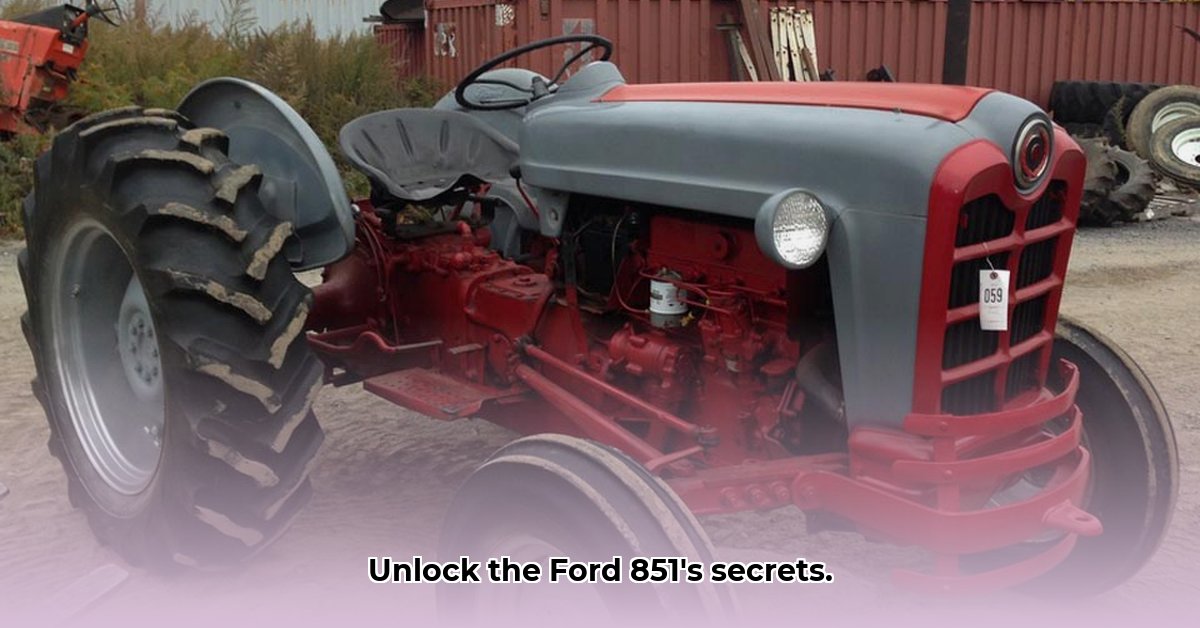
The Ford 851 Powermaster: a robust workhorse of the late 1950s and early 1960s, this tractor holds a significant place in agricultural history. This guide serves as a comprehensive resource for collectors, restoration enthusiasts, and anyone interested in this iconic machine, delving into its design, operation, and lasting impact. Whether you’re troubleshooting a stubborn engine or planning a complete restoration, this guide will equip you with the knowledge you need. For more Ford tractor models, check out this helpful resource.
Powering the Fields: Engine Choices and Performance
One of the 851's defining features was its engine flexibility. Farmers could choose between gasoline, liquid petroleum (LP) gas, or diesel powerplants, offering a unique level of choice for the time. This option reflected a significant advancement in agricultural machinery, providing farmers with tailored power solutions based on individual needs and fuel availability. While power outputs varied slightly—between approximately 40 and 47 kilowatts—each engine delivered sufficient power for a range of farm tasks. Isn't it remarkable how such a seemingly small detail as engine choice impacted farmers' operations?
Shifting Gears and Lifting Loads: Transmission and Hydraulics
The 851 featured a 5-speed unsynchronized transmission (a system where engaging gears requires careful matching of engine speed), demanding skill and precision from the operator. Think of it as driving a classic car with a standard transmission—it requires finesse and experience! The hydraulic system, capable of lifting 1250 pounds, was effective for its time but pales in comparison to the capabilities of modern tractors. This difference underscores the technological advancements in agricultural engineering over the decades. How did these limitations influence the types of tasks farmers could undertake with the 851?
Behind the Wheel: Design and Operation
The 851’s open-station design (no enclosed cab) provided excellent visibility, but also left the operator exposed to the elements. This trade-off, similar to the difference between a convertible and a sedan, highlights the design priorities of the era. Despite the open-air configuration, the inclusion of a 540 RPM power take-off (PTO) – a shaft that transmits power from the tractor to other machinery – showcased a focus on practical functionality. The enduring use of 540 RPM PTO in modern equipment attests to its effectiveness.
Sales Success and Market Standing: Its Rise and Fall
The Ford 851 enjoyed strong sales during its production run, becoming a mainstay on farms across the country. However, its unsynchronized transmission and relatively basic features eventually placed it at a competitive disadvantage against newer models featuring more advanced technologies. Though its technological simplicity ultimately contributed to its decline in the marketplace, the 851 left its mark on a generation of farmers. How did the lack of advanced features influence the long-term viability of the 851?
A Collector's Dream: Preserving a Piece of History
Today, the Ford 851 is highly sought after by collectors and restoration enthusiasts, representing a tangible connection to a bygone era in farming. The process of restoring one of these machines is a labor of love requiring patience and expertise, and their enduring appeal reflects their historical importance. Finding parts remains a challenge, making the restoration process even more engaging.
Comparing the Engine Options: A Closer Look
| Engine Type | Power Output (kW) (approx.) | Fuel Type | Pros | Cons |
|---|---|---|---|---|
| Gasoline | 42 | Gasoline | Widely available fuel; simpler engine design and maintenance. | Lower fuel efficiency; higher maintenance and potential for increased wear. |
| LPG | 44 | LPG | Cleaner burning; potentially lower fuel cost (depending on regional prices). | Requires specialized fuel storage; fuel availability may be limited. |
| Diesel | 46.7 | Diesel | High fuel efficiency; robust engine known for longevity. | Higher initial cost; more complex engine design and maintenance requirements. |
Understanding the Risks: A Risk Assessment
| Component/Technology | Risk Level | Potential Impact | Mitigation Strategy |
|---|---|---|---|
| Unsynchronized Transmission | Medium | Difficult shifting, operator fatigue, potential damage. | Careful operation; regular maintenance and lubrication; operator training. |
| Open Operator Station | Low | Weather exposure, noise, reduced comfort. | Use appropriate protective clothing; acknowledge limitations of the era. |
| Engine (all types) | Medium | Part availability, fuel cost fluctuations, engine wear. | Research parts sources; consider fuel pricing trends; preventative maintenance. |
| Mechanical Hydraulics | Low | Potential leaks; maintenance needs. | Regular visual checks; preventative maintenance; ensure proper fluid levels. |
The Ford 851, while not built to modern standards, is a testament to the ingenuity of a past era and the dedication of those who worked the land. Its enduring appeal demonstrates its significance in agricultural history.
How to Restore a Ford Powermaster 851 Tractor Transmission (A Step-by-Step Guide)
Restoring an 851's transmission is a significant undertaking. This section provides a simplified, high-level overview of the process.
Transmission Identification and Dating: Carefully identify the transmission model using serial numbers, casting marks, and date codes. Use multiple sources for verification. (This ensures you source the correct parts.)
Disassembly and Component Assessment: Meticulously disassemble the transmission, photographing each step. Assess the condition of all components, noting wear and tear. (Detailed documentation is crucial for reassembly.)
Sourcing Parts: Locate necessary replacement parts through online marketplaces, classic tractor parts suppliers, and forums. (Consider contacting restoration specialists for assistance.)
Transmission Reassembly and Testing: Reassemble the transmission carefully, following your photographic documentation. Use the correct lubrication and fluid levels. Conduct thorough testing to ensure smooth shifting and proper operation. (This step requires patience and potentially specialized tools.)
Addressing Common Problems: Repair or replace common worn components, such as synchronizers, gears, and bearings, accordingly. (Preventive maintenance is key.)
Optimizing Your Restoration: Maintain thorough records, be patient, and leverage online forums for support and insights.